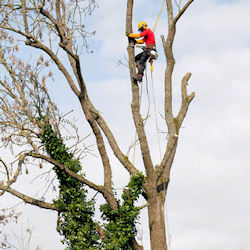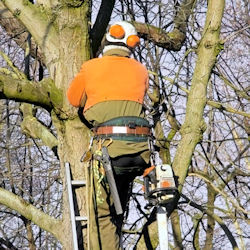31.B Tree Climbing.
31.B.01 Tree Climbing Techniques.
- All tree work operations above a height of 12 ft (3.6 m), whether there are electrical hazards or not, must require a second worker in the area. If climbing is being performed, the second worker must also be a qualified climber, capable and knowledgeable of rescue techniques, including self rescue.
- Use of Rope Access techniques should only be used where other means of accessing the tree or undertaking the work, such as aerial devices or pole saws, are not practical. > See Section 24 for recommended rope climbing equipment, techniques, and safety practices.
31.B.02 The climber must inspect the tree and surrounding area for hazards and perform a risk assessment of the tree and work site. Some issues to be considered are: power lines, tree hangers or broken and dead branches, entanglement with adjacent or downed trees, shape and lean of the tree, tree damage from wind, lightning, disease, location of septic lines and tanks and other potential at-grade or below-grade utilities that could be impacted.
- Debris and other objects must be removed from beneath the climber whenever possible.
- Weather conditions must be assessed as well as location of adjacent structures. Adverse weather conditions may include lightning and thunderstorms in the area.
31.B.03 Where climbing is required, tree crews must have a secondary climber who could assist in a rescue if necessary OR the crew must be working in proximity to nearby crews with a climber who could assist in a rescue.
31.B.04 A climber must have available a climbing line and at least one other means of being secured, on their person at all times (e.g., climbing line and a work positioning lanyard, etc.).
- The climber must be tied in with an approved type of climbing line and safety saddle while ascending the tree, including when using climbing spurs/gaffs.
- The climber must be tied in once the work begins and must remain tied in until the work is completed and he or she has returned to the ground.
- The climber must be secured when repositioning the climbing line.
- Work may be performed while standing on a ladder only when the worker is tied in or secured as required.
31.B.05 The climbing line must be passed around the trunk of the tree as high above the ground as possible using branches with a wide crotch to prevent any binding of the safety line. The crotch selected for tying should be directly above the work area, or as close to such a position as possible, but located in such a way that a slip or fall would swing the climber away from any electrical conductor. The line must be passed around the main leader or an upright branch, using the limb as a stop. Feet, hands, and ropes must be kept out of tight V-shaped crotches.
Exception: Palms and other trees with similar growth characteristics that will not allow a climbing line to move freely.
31.B.06 The climber must tie a stopper knot (e.g., figure-eight knot) in the end of the line, particularly when the climber will be working at heights greater than half the length of the climbing line, to prevent pulling the climbing line accidentally through the climbing hitch and possibly falling.
31.B.07 If it is necessary to re-crotch the climbing line in the tree, the climber must re-tie in or use the safety strap before releasing the previous tie.
31.B.08 The climber working from a stem or spar without a suitable natural crotch must select tie-in points or a tie-in method that positively prevent the climbing line from sliding down or up, or off the stem during climbing operations.
- Placing a climbing line around a stem in an area without a lateral limb is not acceptable unless the climbing line is cinched or choked around the stem or runs through a double-wrapped or adjustable false crotch, which is secured/cinched around the stem.
- The tie-in point selected must be able to withstand the forces being applied during the pruning/removal operation.
31.B.09 Climbers must not carry tools in their hands while climbing. Chainsaws and tools must be raised and lowered one at a time by means of a line, except when working from an aerial-lift device or during topping or removing operations.
31.B.10 Chainsaws used aloft must be secured against falling. Climbers may attach chainsaws weighing less than 15 lbs (6.8 kg) to themselves by means of a saw lanyard.
31.B.11 Climbers must carry a hand saw. When carried aloft, the hand saw must be carried in a scabbard attached to the safety saddle.
31.B.12 Climbing of dead and dying trees must only be performed where no other safe and feasible alternative exists for removal of the tree. Climbers must not trust the capability of a dead branch to support his/her weight. If possible, dead branches should be broken off on the way up and hands and feet should be placed on separate limbs.
31.B.13 Climbing with tree spurs on live trees that are being pruned or otherwise maintained is generally not allowed, in accordance with tree care management standards found in ANSI A300.
- Tree spurs used for thick bark trees must have longer gaffs, such as 2 3/4 in (7 cm). Gaff lengths of 1 3/4 in (4.5 cm) are intended only for pole climbing.
- Gaff lengths must be suitable for the tree being climbed.
Knowledge Check Choose the best answer for the question.
31-4. When carrying and using tools while climbing a tree, workers must NOT _____.
You forgot to answer the question!


